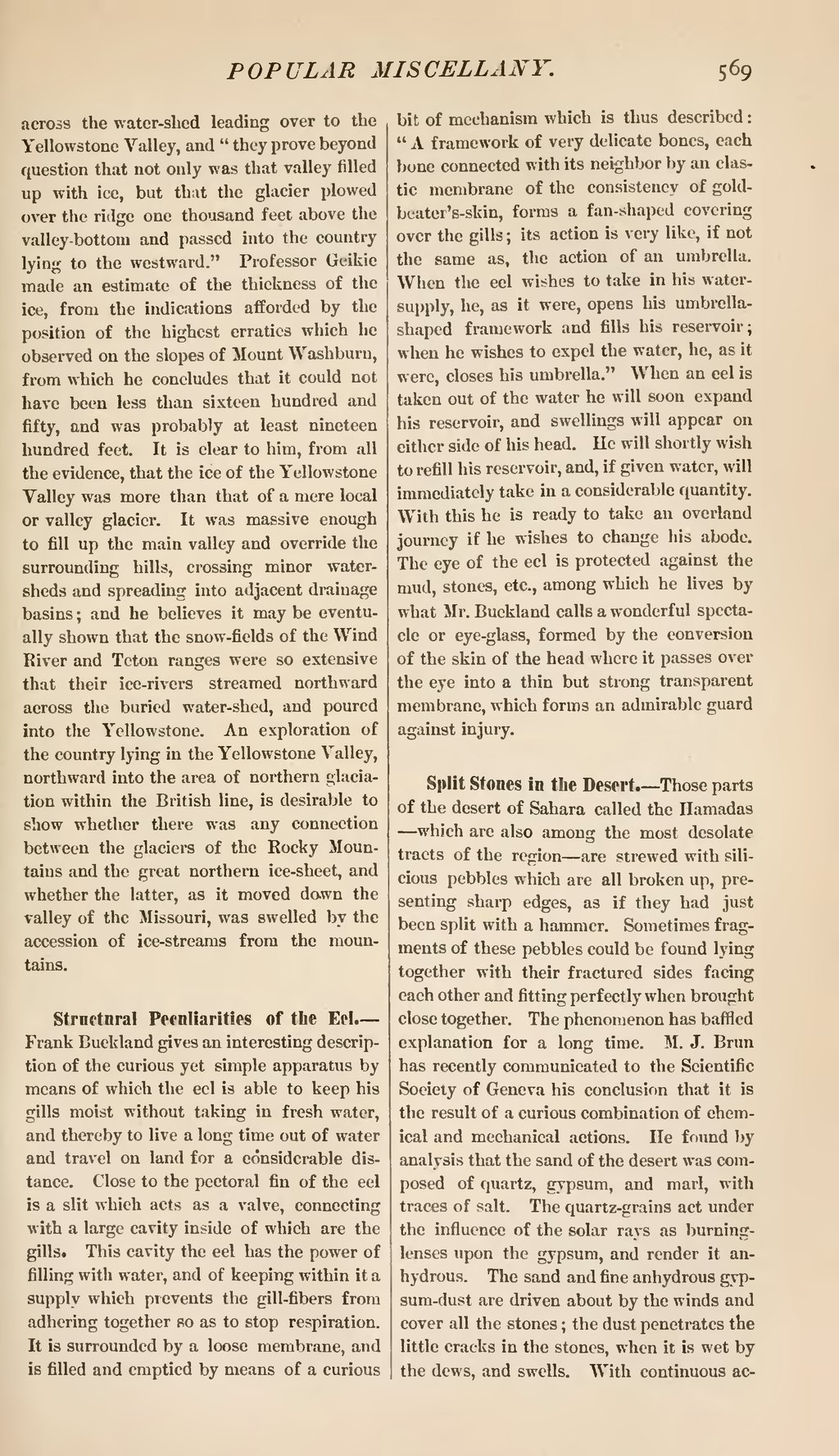across the water-shed leading over to the Yellowstone Valley, and "they prove beyond question that not only was that valley filled up with ice, but that the glacier plowed over the ridge one thousand feet above the valley-bottom and passed into the country lying to the westward." Professor Geikie made an estimate of the thickness of the ice, from the indications afforded by the position of the highest erratics which he observed on the slopes of Mount Washburn, from which he concludes that it could not have been less than sixteen hundred and fifty, and was probably at least nineteen hundred feet. It is clear to him, from all the evidence, that the ice of the Yellowstone Valley was more than that of a more local or valley glacier. It was massive enough to fill up the main valley and override the surrounding hills, crossing minor watersheds and spreading into adjacent drainage basins; and he believes it may be eventually shown that the snow-fields of the Wind River and Teton ranges were so extensive that their ice-rivers streamed northward across the buried water-shed, and poured into the Yellowstone. An exploration of the country lying in the Yellowstone Valley, northward into the area of northern glaciation within the British line, is desirable to show whether there was any connection between the glaciers of the Rocky Mountains and the great northern ice-sheet, and whether the latter, as it moved dawn the valley of the Missouri, was swelled by the accession of ice-streams from the mountains.
Structural Peculiarities of the Eel.—Frank Buckland gives an interesting description of the curious yet simple apparatus by means of which the eel is able to keep his gills moist without taking in fresh water, and thereby to live a long time out of water and travel on land for a considerable distance. Close to the pectoral fin of the eel is a slit which acts as a valve, connecting with a large cavity inside of which are the gills. This cavity the eel has the power of filling with water, and of keeping within it a supply which prevents the gill-fibers from adhering together so as to stop respiration. It is surrounded by a loose membrane, and is filled and emptied by means of a curious bit of mechanism which is thus described: "A framework of very delicate bones, each bone connected with its neighbor by an clastic membrane of the consistency of goldbeater's-skin, forms a fan-shaped covering over the gills; its action is very like, if not the same as, the action of an umbrella. When the eel wishes to take in his water supply, he, as it were, opens his umbrella shaped framework and fills his reservoir; when he wishes to expel the water, he, as it were, closes his umbrella." When an eel is taken out of the water he will soon expand his reservoir, and swellings will appear on either side of his head. He will shortly wish to refill his reservoir, and, if given water, will immediately take in a considerable quantity. With this he is ready to take an overland journey if he wishes to change his abode. The eye of the eel is protected against the mud, stones, etc., among which he lives by what Mr. Buckland calls a wonderful spectacle or eye-glass, formed by the conversion of the skin of the head where it passes over the eye into a thin but strong transparent membrane, which forms an admirable guard against injury.
Spilt Stones in the Desert.—Those parts of the desert of Sahara called the Hamadas—which are also among the most desolate tracts of the region—are strewed with silicious pebbles which are all broken up, presenting sharp edges, as if they had just been split with a hammer. Sometimes fragments of these pebbles could be found lying together with their fractured sides facing each other and fitting perfectly when brought close together. The phenomenon has baffled explanation for a long time. M. J. Brun has recently communicated to the Scientific Society of Geneva his conclusion that it is the result of a curious combination of chemical and mechanical actions. He found by analysis that the sand of the desert was composed of quartz, gypsum, and marl, with traces of salt. The quartz-grains act under the influence of the solar rays as burning lenses upon the gypsum, and render it anhydrous. The sand and fine anhydrous gypsum-dust are driven about by the winds and cover all the stones; the dust penetrates the little cracks in the stones, when it is wet by the dews, and swells. With continuous ac-
